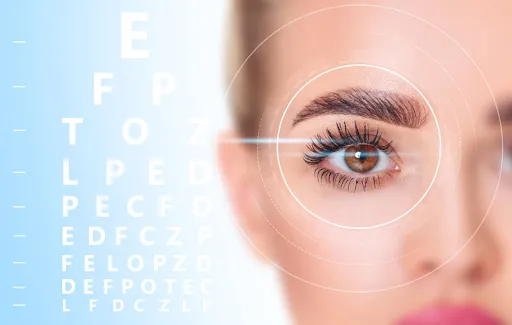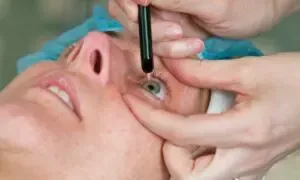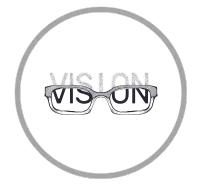Understanding LASIK
Common LASIK Myths: Separating
Fact from Fiction
Common LASIK Myths: Separating Fact from Fiction
FSDAVCFEBFEVSDDVFSD
FSDAVCFEBFEVSDDVFSD
FSDAVCFEBFEVSDDVFSD
LASIK Myths vs. Reality
Have you ever paused at the thought of LASIK due to fear or doubt? Despite its high success rates and technological advancements, numerous myths persist about LASIK surgery. One widespread belief is that the procedure is extremely painful, which is far from the truth.

As we move forward, we aim to clarify these misconceptions, providing you with accurate and useful information. Join us as we unpack the facts, dispelling the most common myths about LASIK, to help you understand what truly awaits should you consider this vision-correcting surgery.
Have you ever paused at the thought of LASIK due to fear or doubt? Despite its high success rates and technological advancements, numerous myths persist about LASIK surgery. One widespread belief is that the procedure is extremely painful, which is far from the truth.
As we move forward, we aim to clarify these misconceptions, providing you with accurate and useful information. Join us as we unpack the facts, dispelling the most common myths about LASIK, to help you understand what truly awaits should you consider this vision-correcting surgery.


Myth 1: LASIK is Excruciatingly Painful

Contrary to the daunting myth, LASIK is not an excruciating experience. Before the procedure begins, patients receive numbing eye drops that effectively block any pain during the surgery. While it's true that some may feel slight pressure or discomfort when the surgeon creates the corneal flap, this sensation is typically mild and brief.
Moreover, the entire LASIK procedure is remarkably quick, often taking only about 15 minutes for both eyes. After the surgery, most patients report minimal discomfort, usually described as a gritty or sandy feeling, which subsides within a few hours. Over-the-counter pain relievers and lubricating eye drops are generally sufficient to manage any post-operative irritation.
Contrary to the daunting myth, LASIK is not an excruciating experience. Before the procedure begins, patients receive numbing eye drops that effectively block any pain during the surgery. While it's true that some may feel slight pressure or discomfort when the surgeon creates the corneal flap, this sensation is typically mild and brief.
Moreover, the entire LASIK procedure is remarkably quick, often taking only about 15 minutes for both eyes. After the surgery, most patients report minimal discomfort, usually described as a gritty or sandy feeling, which subsides within a few hours. Over-the-counter pain relievers and lubricating eye drops are generally sufficient to manage any post-operative irritation.

The swift recovery and minimal discomfort associated with LASIK make the myth of it being excruciatingly painful completely unfounded. Additionally, the post-operative care includes detailed instructions and follow-up visits to ensure a smooth recovery. Patients can expect significant improvements in vision within 24 hours, making LASIK a highly efficient and comfortable option for vision correction.
Myth 2: Questions Over LASIK's Safety and Durability
Concerns about LASIK's safety and its long-term effectiveness are often misplaced. This surgical procedure has a longstanding track record of both safety and durability, backed by extensive clinical studies and patient data. Since its FDA approval in the late 1990s, millions of LASIK surgeries have been performed with a high satisfaction rate. The procedure has a complication rate of less than 1%, which is considerably low compared to other elective surgeries. Moreover, the improvements made in LASIK technology over the years have only enhanced its safety profile and effectiveness.
Studies show that the majority of patients achieve 20/20 vision or better following the procedure and that these results are stable, with significant corrections enduring decades. These outcomes highlight LASIK's reliability as a long-term solution for vision correction.
Additionally, LASIK has been shown to have a rapid recovery time, with most patients returning to their normal activities within a few days. The procedure itself is quick, often completed within 30 minutes, and involves minimal discomfort. Furthermore, advancements such as wavefront technology allow for a more customized approach, addressing even minor imperfections and improving overall visual quality. As a result, LASIK continues to be a trusted and popular choice for those seeking freedom from glasses and contact lenses.
Myth 3: LASIK's Limited Treatment Range
A common misconception is that LASIK only corrects nearsightedness (myopia), but its capabilities extend far beyond that. LASIK can effectively correct a wide range of refractive errors, including farsightedness (hyperopia), astigmatism, and even presbyopia, which typically requires the use of reading glasses. The procedure uses advanced laser technology to reshape the cornea, allowing it to properly focus light onto the retina, thereby correcting the specific visual impairment.
Technological advancements in LASIK have also led to the development of customized treatments, such as wavefront-guided LASIK, which can address higher-order aberrations that standard procedures might miss. This means that even those with complex or unique vision issues can benefit from LASIK. By expanding its range of treatments and offering tailored solutions, LASIK provides a versatile and effective option for many people seeking to improve their vision, debunking the myth of its limited treatment range.
Myth 4: The Temporary Nature of LASIK Corrections
The belief that LASIK provides only temporary relief from vision problems is a significant misunderstanding. In reality, the changes made to the cornea during LASIK surgery are permanent. The laser meticulously reshapes the cornea, correcting the refractive error that causes nearsightedness, farsightedness, or astigmatism.
This alteration is designed to last, with the reshaped cornea maintaining its new form indefinitely. While it's true that some individuals might experience shifts in their vision over many years due to natural changes related to age, such as presbyopia or cataracts, these are not direct results of LASIK itself. Thus, the notion that LASIK only offers a temporary fix is incorrect, making this another myth that can be confidently dismissed.

The belief that LASIK provides only temporary relief from vision problems is a significant misunderstanding. In reality, the changes made to the cornea during LASIK surgery are permanent. The laser meticulously reshapes the cornea, correcting the refractive error that causes nearsightedness, farsightedness, or astigmatism.
This alteration is designed to last, with the reshaped cornea maintaining its new form indefinitely. While it's true that some individuals might experience shifts in their vision over many years due to natural changes related to age, such as presbyopia or cataracts, these are not direct results of LASIK itself. Thus, the notion that LASIK only offers a temporary fix is incorrect, making this another myth that can be confidently dismissed.

Furthermore, for those who do experience minor vision changes post-LASIK, enhancement procedures can be performed to fine-tune the correction. The need for such enhancements is relatively low, and they are typically straightforward. Overall, LASIK's lasting impact on vision correction continues to provide enduring clarity and improved quality of life for countless individuals.
Myth 5: Universal LASIK Eligibility
A common misconception is that LASIK is a one-size-fits-all solution. While LASIK offers significant benefits for vision correction, it's not suitable for everyone. Eligibility for LASIK is determined based on a variety of criteria, including the health of the eye, the thickness of the cornea, and the stability of the patient's vision.
Individuals with certain eye conditions, such as severe dry eyes or corneal diseases, may be advised against LASIK. Similarly, those with fluctuating vision prescriptions, such as young adults whose vision has not yet stabilized, are typically not ideal candidates.
Prospective patients must undergo a comprehensive eye examination and consultation with an experienced ophthalmologist to assess their suitability for the procedure. Thus, the belief that everyone can undergo LASIK is effectively debunked.
Myth 6: Complicated and Prolonged Recovery From LASIK
The recovery process from LASIK is often presumed to be lengthy and fraught with complications. However, this perception doesn't align with the experiences of most patients. In reality, LASIK recovery is notably swift and straightforward.
Most individuals notice a significant improvement in their vision almost immediately after the procedure, and the majority return to their regular activities within a day or two. Patients typically experience minimal discomfort during the recovery phase, which may include mild irritation and light sensitivity for a few hours post-surgery.
Eye doctors often recommend simple aftercare routines, such as using prescribed eye drops to prevent infection and aid in healing. This efficient recovery process dispels the myth of a difficult recovery period, highlighting LASIK's appeal as a convenient and low-risk option for vision correction.
Let’s Wrap Thing Up
As we've clarified throughout this discussion, many myths surrounding LASIK do not hold up under scrutiny. By dispelling these myths, we help potential patients make informed decisions based on facts rather than fear.
LASIK has transformed the lives of millions, offering a safe and effective solution for those who are suitable for the procedure. If you're considering LASIK and wondering about its benefits and suitability for your specific vision needs, consult with the experienced professionals at Kleinwood Vision.
Contact us today to learn more about LASIK and to see if it could be the right solution for enhancing your vision.

Contact Info
Hours of Operation
Mon - Fri | 9:00 AM - 5:00 PM
Sat - Sun | Closed
Holiday Hours: We are closed for the following holidays: New Years Day, Memorial Day, Independence Day, Labor Day, Thanksgiving Day, Christmas Day
© 2025 Kleinwood Vision. All rights Reserved.


